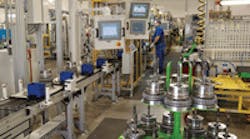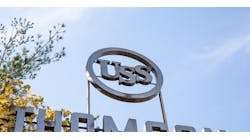When manufacturers are faced with streamlining their production, executives and manufacturing engineers often have to weigh the relationship between flexibility, production rates, production volumes and changeover time.
One element ultimately overlaps into the next. But finding the right balance between these building blocks isn't easy.
General Motors Co., though, has achieved some eye-opening results on its front-wheel transmission line at its powertrain plant in Toledo, Ohio, cutting weeks of production down to hours through a partnership with Siemens, which integrated the control elements to create a highly flexible automated system.
GM's front-wheel drive transmission line is focused on smaller, more fuel-efficient vehicles, such as the Chevy Malibu and the new Chevy Cruze, and is ramping up to its initial goal of 2,200 units per day.
Siemens Automotive Center for Competence provided the PLC, CNC, HMI, RFID and its high-level Ethernet protocol, Profinet, to run on the network, while software vendor Elite Engineering added its Flexible Assembly Configuration System (FACS), complemented by Siemens to create its SIFACS solution.
One of the primary keys to the project's success, according to GM, was a partnership between technical specialists in safety integrated systems and industrial communications. The result was a decentralized control network that worked in harmony with the overall workflow of the plant, which not only addressed multiple families of hardware involved but also coordinated all code development, safety, and communications functions into a seamless, interdependent yet highly adaptive control scheme.
The system was coordinated under the Siemens Transline architecture, which provides a uniform user interface for operational and diagnostic functions on the vast majority of the various machine tools, transfer lines, robotics, assembly machines, sensing devices and vision systems throughout the facility.
As a workpiece proceeds through the line, each pallet is equipped with an RFID tag.
"The key here is the data throughput in the system, as it directly impacts the cycle time or takt of the line," says Reinhold Niesing, engineering manager on the project for Siemens. "The tags must be able to function in static mode, whereby the data on the part must be read before the process begins. Model number, serial number and build status information are all contained in the tag. The faster we read the information, the faster the process begins."
According to Niesing, the information at subsequent line stations must be read "on the fly" without any line stoppage, as is often seen in conventional packaging, shipping or other line applications for RFID. In this case, all data is read as the tag passes by the antenna.
For all the sophistication of the RFID hardware, the system still communicates easily with the plant's existing common protocols.
George Jewell, the GM engineer responsible for the implementation of the FAC online at the Toledo plant, explained that one of the goals in the line development was to have consistent logic blocks at each station. This would allow immediate successive modifications to be made in the machine or assembly operations performed, throughout all stages of the line.
By standardizing on the hardware, software and communication protocols used, engineering costs could be contained and, as a collateral but vital side effect, maintenance on the system could be made more efficient with much of the system hardware exposed on the line, rather than enclosed in electrical cabinets. Flexible modules would allow more rapid reconfiguration, product changes, and a genuine synergy with the ongoing GM commitment to continuous improvement in the line, as the new GF6 transmission ramped up to incremental target levels of production.
Rather than textbook product life cycle management, Jewell sees FACS as more of a production line lifecycle management tool, as its inherent adaptability means common hardware can be made to do diverse tasks, at varying rates, with on-the-fly changeover, in far less time than previously possible.
"We've seen great results, with activities that took months reduced to weeks and what took weeks reduced to hours," says Jewell. "There's less ramp-up time, plus the changeover and line balancing upsides are already proving this was a beneficial investment."
See Also:
• NIST Tackles Security Concerns on the Cloud




